I’ve never eaten a pasty, but I hope to try one soon. How can you go wrong with beef stew in a homemade hot pocket? This Cornish delicacy boasts a thick crust that—according to the legend—once served more as a handle than a soft braided treat in the dirty hands of a 19th century miner.
There aren’t many games that make me look up recipes, but the recent Remaster of Tinners’ Trail from Martin Wallace (Brass, Age of Steam, AuZtralia , Rocket Men) accomplished just that. Right there on the cover, a mustachioed miner holds the tantalizing treat before our noses, begging us all to lick our chops and hop a steam ship to Cornwall for a whiff of pasty goodness.

Give the box a second glance, though, and you’ll realize—like I did—that Tinners’ Trail is more about the mining than the miners’ hearty snacks. Having never played the original 2008 production, but being a fan of the absurdly gratuitous theme potential in a Martin Wallace production, I was excited to explore the mines to see what riches lay beneath.
Precious Metal is Hard to Find
As it turns out establishing an effective mining operation in the 1800’s required a bit of setup, but in setting up the game the necessary intuitions become quite obvious, as they are actually printed right there on the board.
The board itself features six actionable areas. I’ll treat each one, and it’s game activity, individually.
The Market
At the outset of each of the game’s four rounds, dice are rolled to set the market price for tin and copper, the booty of the mines. The dice are colored in homage to the original print of Tinners’ Trail, where they served their purpose in a different manner. Here the dice are rolled and totaled to establish the values of the ores. One of the game’s delightful tensions is mining the right ore at the right time to strike it rich.
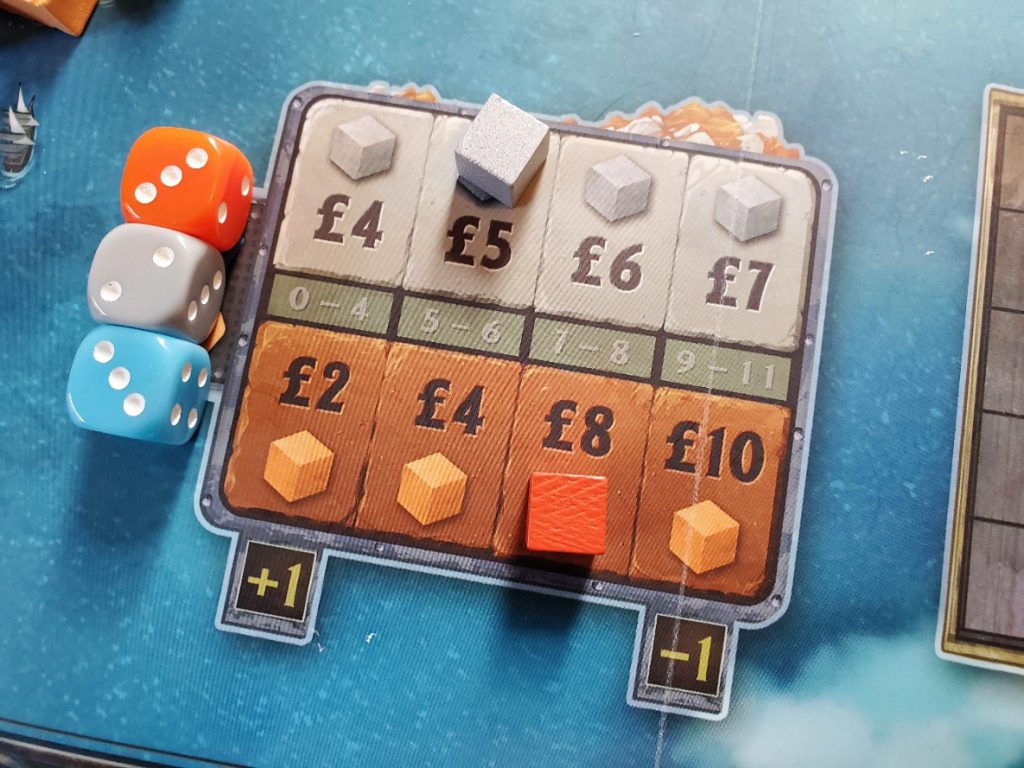
The Map
Cornwall, the most southwestern tip of England, takes center stage on the board. It is divided into a number of areas that will mostly feature hidden tiles containing the mining potential. Various player counts reveal certain mines during setup. Based on these varying levels of knowledge, players will auction areas in order to earn the right to extract precious copper and tin to sell in the fluctuating market.
During each auction, a survey card may come into play, revealing what will become a boost in resources or the removal of excess water (the miners’ enemy and the cause of economic woe!). The initiating player may use one of their own survey cards, which also grants them a peek at the hidden tile and, therefore, an advantage in the auction. Or in a two player game, surveys may come from the deck as well. If the initiating player chooses not to employ a survey and another player wins, that player may then use a survey card of their own.
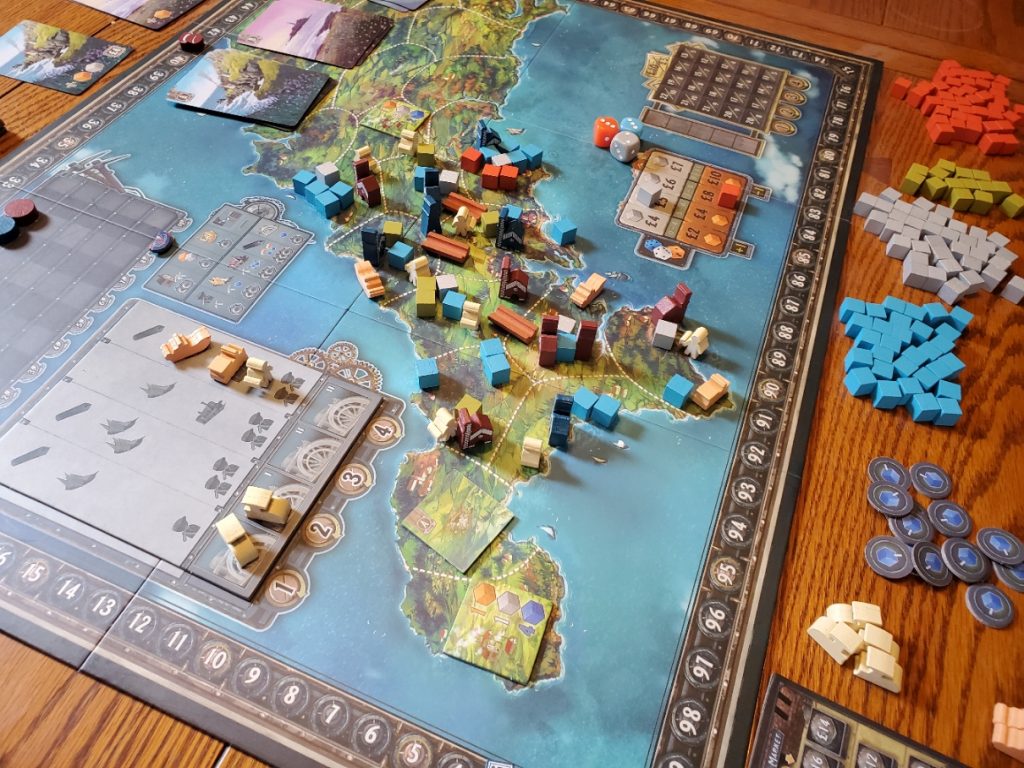
Following the auction, the winner assumes control of the region, placing their mine and replacing the tile with the indicated tokens. If the player who initiated the auction loses, they are compensated with half the price paid and the opportunity to take a different work action.
The Work Track
Each round consists of up to ten action points for each player, accounted for on the Work Track. After the opening, turn order is determined by who has spent the fewest points thus far. The last shall be first, not unlike Tokaido and others like it. Based on the resources available, players choose from nine actions, each requiring a different number of work points:
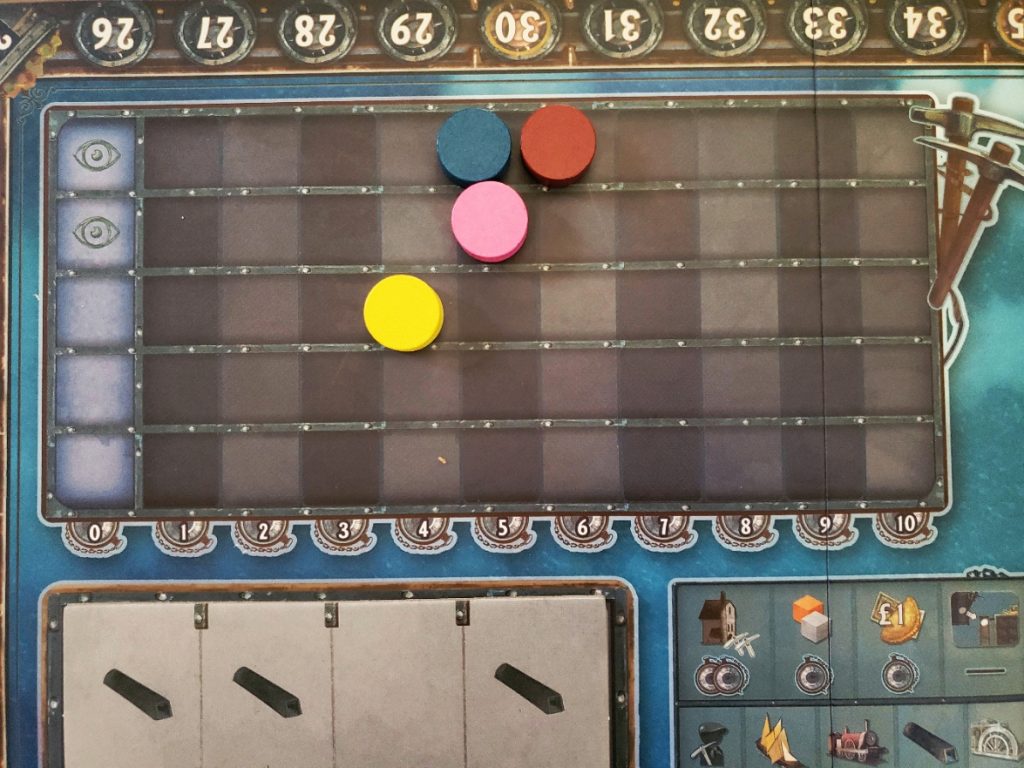
- Build mines by initiating and winning auctions
- Extract ore from your mines, collecting the tin & copper from your area
- Sell those delicious pasties for £1
- Acquire miners to boost the number of resources that can be extracted
- Build a port to remove water and boost extraction
- Introduce a steam engine to remove water from multiple areas
- Develop an adit, which removes water and boosts ore production
- Employ a steam pump to remove water swiftly
- Pass

Ore extraction has a monetary cost equal to the number of water tokens in an area, thereby creating the need for all those mechanical means of water removal. Extraction is also limited by the strength of labor available, hence the need for human and engineered power. Every extraction reveals additional water in the mine, so sharp eyes are always required to manage the H2O. Much of the tension and strained efficiency along the trail finds roots in these mechanics.
There are numerous strategic opportunities in working the Work track, so to speak. In order to participate in auctions, players must have the necessary Work action points to win the auction, which opens the door to well-timed real estate gains. Likewise, seizing the right moments to take a series of small actions after your opponent reaches for something large could make a difference in a round’s investments. Passing first to gain the most lucrative investments while also obtaining the next round’s first move and a free peek into a mine can also swing momentum along the trail.
The Development Board
All of the game’s available developments—adits, workers, ports, trains, and steam pumps—are visible on this board from the beginning, which has a home near the map. Only a certain number will be available in any given round, but with the future in sight, planning ahead is helpful. The four included boards change out based on the player count, adjusting the realm of possibility and providing balance for every combination of players.
The only development that shifts and grows within the game is the steam pump. Additional pumps are introduced with each round, adding a bit of dynamism and ease to water removal as mining expands.
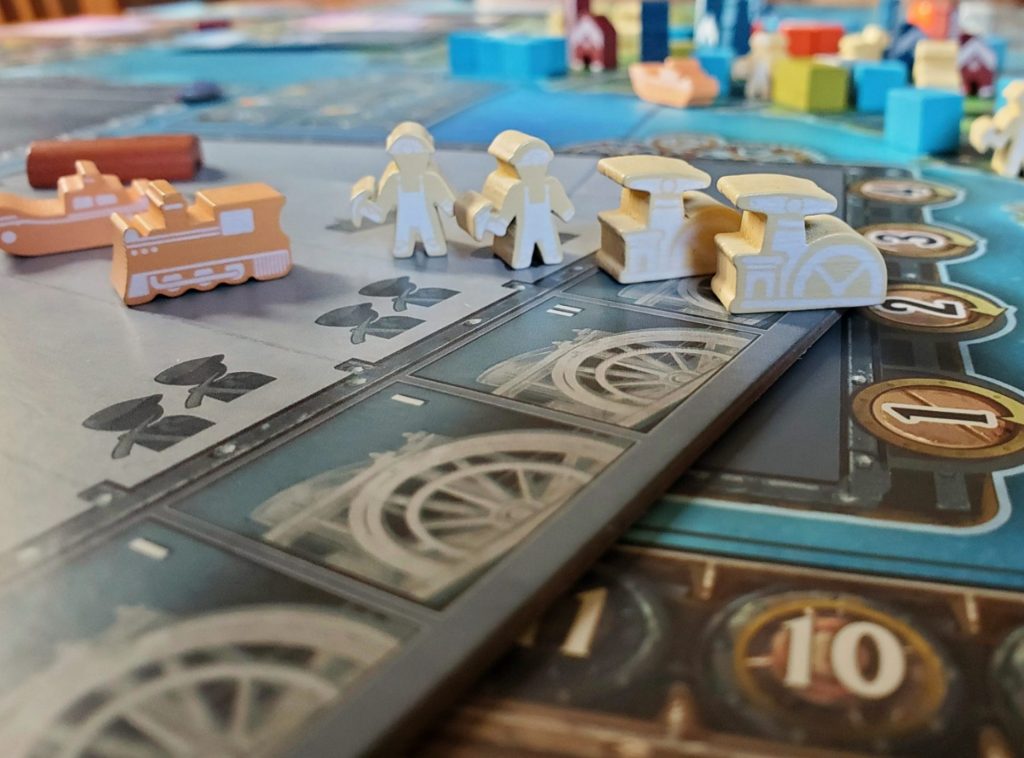
The Investment Board
When a player eventually passes after spending their action points, their work token is moved to the investment board signaling the end of their work phase. The variations in the work action points mean players will arrive in an order of their choosing, which has lingering implications.
First, all players simultaneously sell all of their extracted ore according to the rolled market cost, collecting the appropriate funds. Using the investment board as a guide, players then take turns investing their money and collecting victory points. Investments are made in increments of £5 and £10, each receiving a certain number of points based on the round.

With each passing round the investment board pays less, creating a nice tension as useful cash is traded for ultimate glory. Players invest in turns until all pass, at which point the player markers are moved back to the Work Track—in order—setting up the next round. The players in the top positions are then able to peek at one hidden mine as a cherry on top of the previous round’s hard work.
After the dice are rolled to set new market prices, play continues, utilizing a fresh work track and a new round of boosters on the development board. After four rounds, points are calculated and a winner is crowned!
The Money & Score Track
Cash and victory points are tallied around the outside of the board on a singular track using separate tokens. This crowds the path, but allows all players the opportunity to easily track what can become hundreds of pounds and hundreds of points over the course of the entire game.
Down in the Hole and Down in the Mine
The recent Kickstarter was accompanied by two modular expansions, the Lord Wallace solo mode, additional game tiles, and the promise of three months’ exclusivity before the game hits retail shelves. I’ve not played the solo mode, but the expansions have seen the table. And let’s be honest, Alley Cat Games (Dice Hospital, Cat Cafe) won a few friends and influenced a few people by following through with the exclusivity.
The Arsenic expansion adds the valuable-byproduct-turned-poison we all know and love. Each player gains the opportunity to add one calciner to a mine, adding arsenic to the spoils of the surrounding areas. Arsenic can be harvested without spending even a work action point, but the cost is steep, costing one slot on the work action track for the remainder of the game. Once harvested, arsenic sells for a pretty penny, so it is a timely sacrifice that is to be leveraged wisely.
The Emigration expansion allows players to move their own workers who, after digging to their heart’s content, now skip town and try their fortune elsewhere. Of course, loving their Cornish home, they send home the spoils of their adventures to help the mining cause.
Both expansions grant worthwhile rewards, but raise the ante on risky decisions.
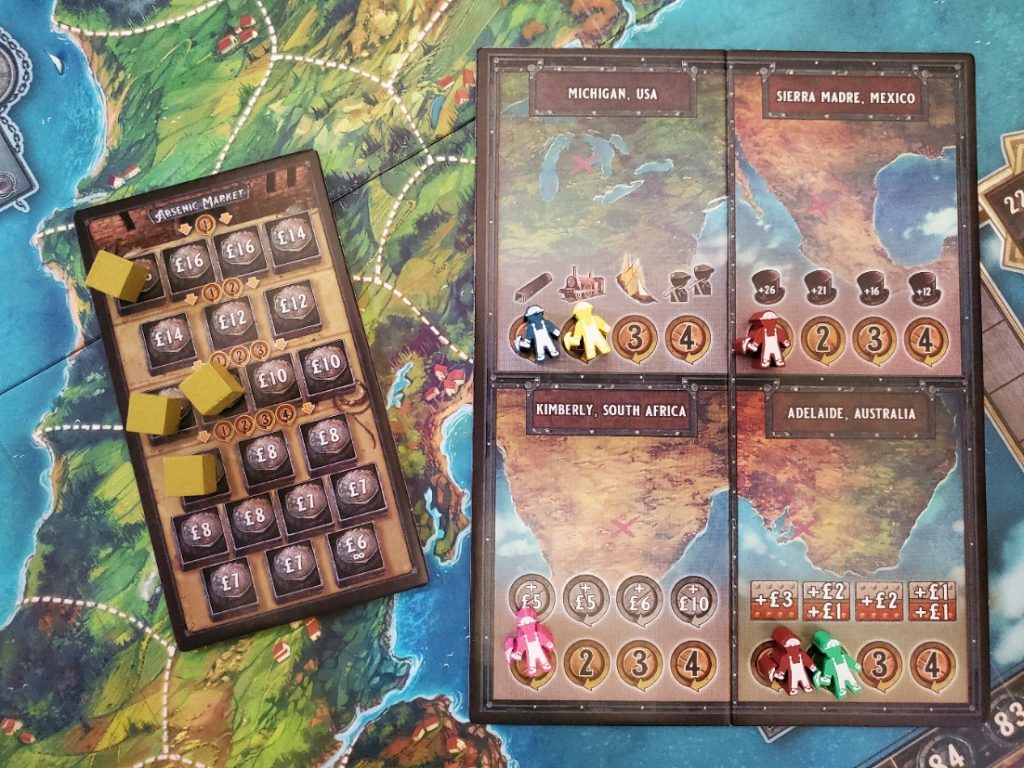
And I Dig My Life Away
I’m not afraid to show my cards right away: I like Tinners’ Trail. The art is charming, the theme is so thorough it made me sad, it brought my family to the table, and it might just bring a pasty to my belly. What more could I ask?
As with a number of Martin Wallace experiences, setup and tear-down will take a few minutes. There are baggies and baggies, pieces upon pieces. Such a deep economy requires cubes and cutouts and meeples and mines, ships and steam engines, top hats and tuppence. Personally, I love setting up the spread when there is so much game waiting on the other side. Truth be told, I don’t mind clean-up either. Perhaps I’m strange.
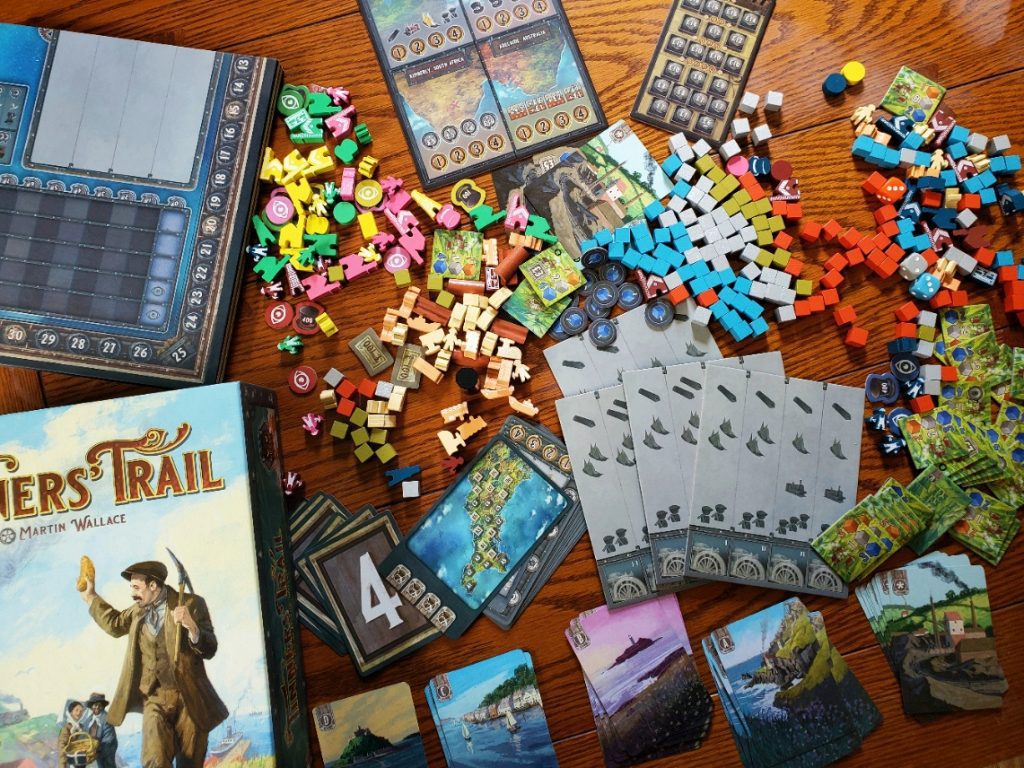
Our first game was five players and included three of my children—the middle schoolers. They all handled the strategy. They all loved the gameplay. The Trail was actually a decent hit for multiple generations of gamers. I call that a win!
If I had to offer one complaint, it would be the size of the board. I don’t mind cubes, and I like the sizes of the various components, but some of the areas get cramped in a hurry. If the board filled the box, I might not even complain, but the fact that there is such a gap in there makes this design painful. Pretty or not, I wish the map were a touch larger, or that certain elements of the game engine were moved to a side board in order to give additional space to the principal area of labor.
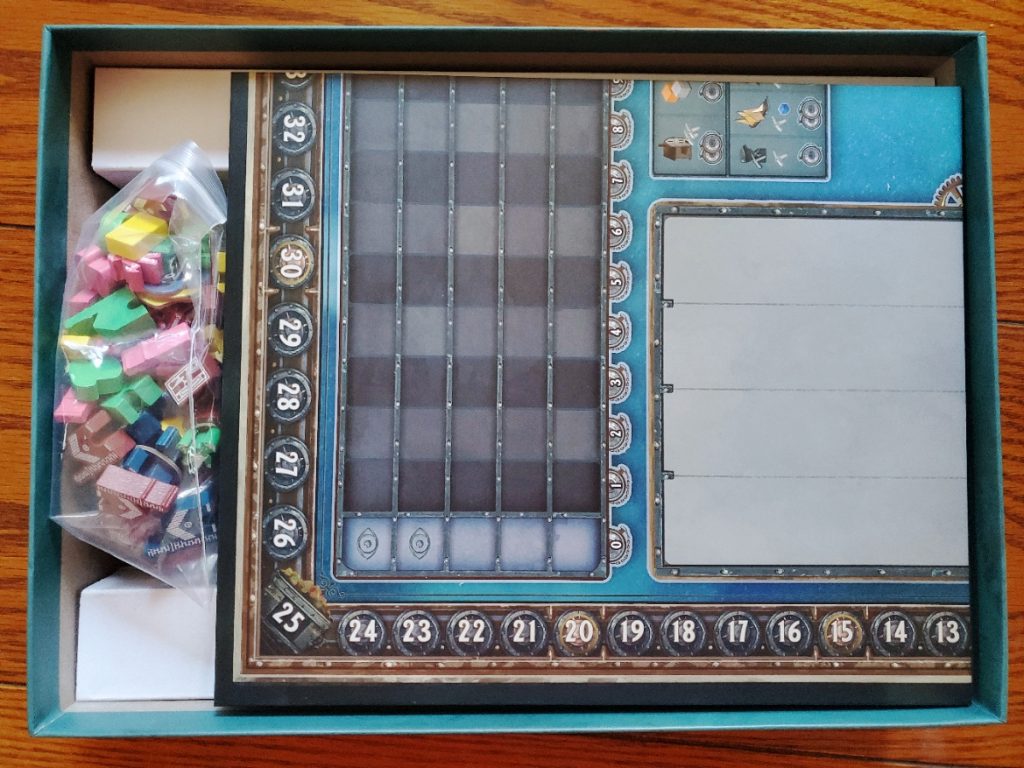
If I had to offer a second complaint, I wouldn’t. But I can understand why some might dislike bidding blindly on mining areas. There is a risk in doing so, but it is a risk that is near perfectly in line with the thematic reality. Land surveys can help, but at the end of the day, the only way to determine what’s in the ground is to take a pick and start digging into land you own. There are ways to peek in advance and ways to enhance weak territories that offset some of the less favorable draws.
Why on earth did this theme make me sad? Well, after playing the game at three players, I sat at the conclusion and looked over the scenario. The entirety of Cornwall, which had been bustling with ore production, pasty sales, laborers, and industry at the beginning, had become a depressed and depressing void of spent potential. Mining has its limits, and the job of the tinner in this game is to push those limits to their breaking point. The Emigration expansion only rubs salt in the wound, as not only the resources disappear, but so do the capable laborers as they leave the wasteland in favor of accomplishment around the world. As abandoned mines dot the landscape, the map assumes a less encouraging imaginative posture. It made me want to sit around and watch to see if some other industry would sweep in and raise the people to their former glory. Maybe a Cornish tech company sets up a creative space along that gorgeous coast?
Because a two-player game leaves little room for sacrifice, the Arsenic expansion seems better suited for the higher player counts. The resources are tight with five at the table, which occasionally leaves an extra Work Action or two at a round’s end. Rather than selling pasties for a pound, these are the moments ripe for selling off the toxic fallout.
You already know my opinion. The reality of a game like this is, if you know how deep and wide and long it is, and you’re interested, then you should play it if the opportunity arises. The artwork is beautiful. The theme is rich. The mechanics are engaging. The decisions are interesting. And let’s not forget those enticing pasties.
One year later…
Tinners’ Trail remains a stalwart in the collection. It doesn’t see the table every day, but I can honestly say I would play right now if someone were to ask. There is a lot of setup and a fair investment of time involved in each play, but every game is a delight. I feel the promise and the agony of unearthing and depleting the wealth of the land every time. Not two weeks ago, a friend mentioned wanting to learn the game, so I’m excited at the prospect of introducing it yet again to get a few more experiences under my belt. The mechanics have the sort of staying power that validate the reprinting and simultaneously suggest that the Trail isn’t going anywhere anytime soon.


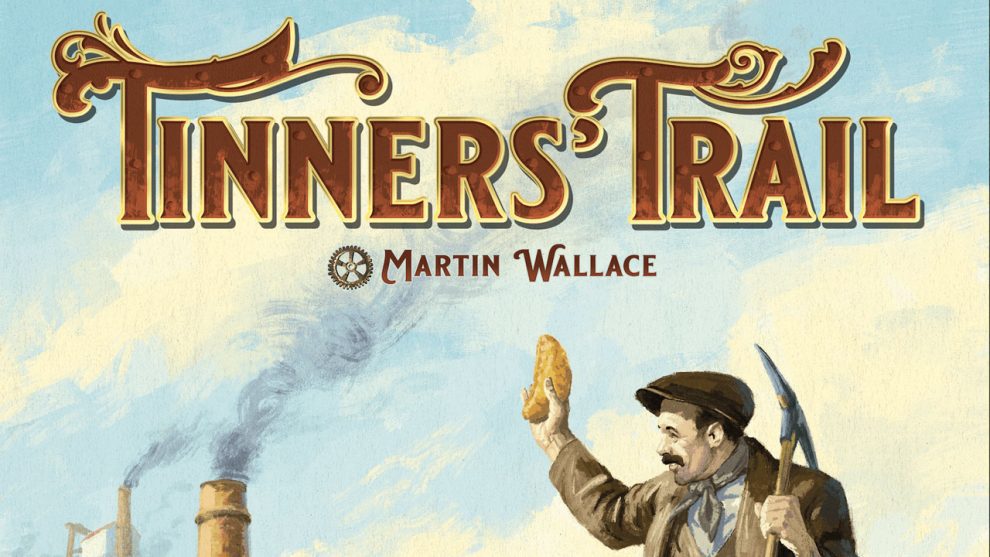









Add Comment